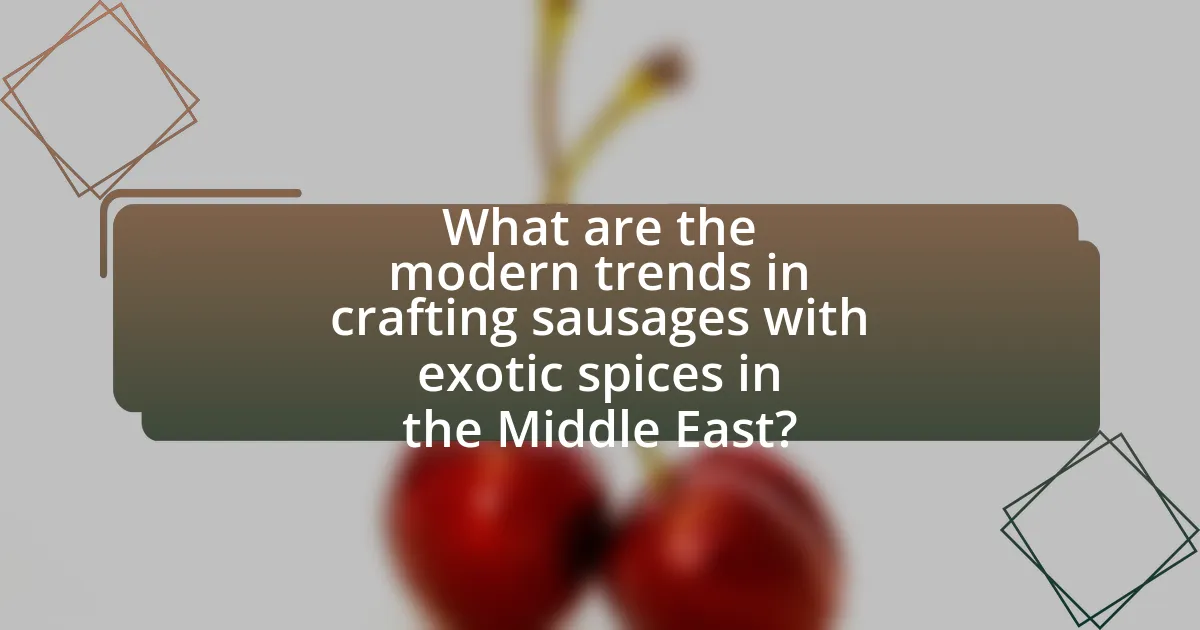The article focuses on the art of crafting sausages with exotic spices in the Middle East, highlighting the importance of high-quality meats, traditional techniques, and a diverse range of spices such as sumac, za’atar, and cumin. It explores how these spices influence flavor profiles, the regional variations in sausage-making practices, and the cultural heritage that shapes these culinary traditions. Additionally, the article discusses modern trends, challenges faced by artisans, and practical tips for home cooks looking to create their own Middle Eastern sausages, emphasizing the significance of preserving traditional methods while embracing innovation.

What are the fundamentals of crafting sausages with exotic spices in the Middle East?
The fundamentals of crafting sausages with exotic spices in the Middle East include selecting high-quality meats, incorporating a variety of spices, and using traditional techniques. High-quality meats such as lamb, beef, or chicken are essential for flavor and texture. Exotic spices like sumac, za’atar, and cumin are commonly used to enhance the taste profile, reflecting the region’s culinary heritage. Traditional techniques, including proper seasoning, mixing, and stuffing into casings, are crucial for achieving the desired consistency and flavor. These practices are rooted in the region’s history, where spices have been integral to food preservation and flavor enhancement for centuries.
How do exotic spices influence the flavor profile of Middle Eastern sausages?
Exotic spices significantly enhance the flavor profile of Middle Eastern sausages by introducing complex and aromatic notes that define their unique taste. Spices such as cumin, coriander, and sumac contribute earthy, citrusy, and warm flavors, while others like cinnamon and allspice add sweetness and depth. The use of these spices is rooted in historical culinary traditions, where they were valued not only for flavor but also for their preservative qualities. For instance, cumin has been used for centuries in Middle Eastern cuisine, providing a distinctive warmth that complements the richness of the meat. This combination of spices creates a harmonious balance, making Middle Eastern sausages rich in flavor and culturally significant.
What are the most commonly used exotic spices in Middle Eastern sausage making?
The most commonly used exotic spices in Middle Eastern sausage making include sumac, coriander, cumin, and allspice. Sumac adds a tangy flavor, while coriander and cumin provide warmth and earthiness. Allspice contributes a unique aromatic quality, often described as a blend of cinnamon, nutmeg, and cloves. These spices are integral to traditional recipes, enhancing the overall flavor profile of the sausages and reflecting the rich culinary heritage of the region.
How do these spices vary by region within the Middle East?
Spices in the Middle East vary significantly by region, influenced by local agriculture, climate, and cultural practices. For instance, in the Levant region, spices like za’atar and sumac are prevalent, reflecting the Mediterranean climate that supports the growth of these herbs. In contrast, the Arabian Peninsula favors spices such as saffron and cardamom, which are often used in traditional dishes like kabsa, highlighting the region’s historical trade routes and culinary influences. Additionally, Iran is known for its use of saffron and turmeric, which are integral to Persian cuisine, showcasing the diversity of spice usage across the Middle East. This regional variation is further supported by historical trade patterns, where spices were exchanged along the Silk Road, leading to distinct culinary identities in each area.
What traditional techniques are used in sausage crafting in the Middle East?
Traditional techniques used in sausage crafting in the Middle East include the use of natural casings, specific spice blends, and methods of smoking or drying. Natural casings, often made from sheep or goat intestines, are preferred for their ability to enhance flavor and texture. Spice blends typically feature ingredients like cumin, coriander, and sumac, which are integral to the region’s culinary identity. Additionally, sausages may be smoked or air-dried to develop unique flavors, a practice rooted in historical preservation methods. These techniques reflect the rich cultural heritage and culinary traditions of the Middle East.
How does the preparation process differ from Western sausage making?
The preparation process of Middle Eastern sausage making significantly differs from Western sausage making primarily in the use of spices and meat preparation techniques. Middle Eastern sausages often incorporate a diverse range of spices such as sumac, coriander, and cinnamon, which are blended into the meat mixture, enhancing flavor profiles unique to the region. In contrast, Western sausage making typically relies on a more limited selection of spices, focusing on salt, pepper, and sometimes herbs like sage or thyme. Additionally, Middle Eastern sausages may utilize a variety of meats, including lamb and beef, often ground coarsely, while Western sausages frequently use pork or a combination of meats that are finely ground. This distinct approach to seasoning and meat selection reflects cultural preferences and culinary traditions, showcasing the rich diversity in sausage preparation across different regions.
What role does cultural heritage play in these techniques?
Cultural heritage plays a crucial role in the techniques of crafting sausages with exotic spices in the Middle East by preserving traditional recipes and methods passed down through generations. These techniques often reflect the unique culinary practices, regional ingredients, and historical influences of various cultures within the Middle East, such as the use of specific spices like sumac and za’atar, which are integral to the flavor profiles of the sausages. For example, the preparation of Merguez, a North African sausage, showcases the blend of Berber and Arab culinary traditions, highlighting how cultural heritage shapes not only the ingredients used but also the preparation methods and serving styles. This connection to cultural heritage ensures that the techniques remain authentic and continue to celebrate the rich history and diversity of the region’s gastronomy.
Why is the choice of meat important in crafting Middle Eastern sausages?
The choice of meat is crucial in crafting Middle Eastern sausages because it directly influences flavor, texture, and cultural authenticity. Different meats, such as lamb, beef, or chicken, impart distinct tastes and characteristics that align with regional preferences and traditional recipes. For instance, lamb is often favored for its rich flavor and is commonly used in Middle Eastern cuisine, while beef may be chosen for its firmer texture. Additionally, the type of meat affects the sausage’s ability to absorb spices, which are integral to the dish’s overall profile. Historical practices also dictate meat selection; for example, lamb has been a staple in Middle Eastern diets for centuries, reinforcing its significance in traditional sausage-making.
What types of meat are traditionally used in these sausages?
Traditionally, lamb and beef are the primary types of meat used in Middle Eastern sausages. These meats are favored for their rich flavors and textures, which complement the exotic spices commonly incorporated into the sausage recipes. Historical practices in regions such as the Levant and the Arabian Peninsula highlight the use of lamb, often due to its availability and cultural significance, while beef is also prevalent, particularly in urban areas where it is more accessible.
How does the meat selection affect the final product?
The selection of meat significantly influences the final product in sausage making by determining flavor, texture, and fat content. Different types of meat, such as lamb, beef, or pork, impart unique taste profiles and moisture levels, which are crucial for the overall quality of the sausage. For instance, lamb is often favored in Middle Eastern sausages for its rich flavor and higher fat content, which enhances juiciness and mouthfeel. Additionally, the cut of meat selected affects the texture; lean cuts may result in a drier sausage, while fatty cuts contribute to a more succulent product. Studies have shown that the balance of meat and fat is essential for achieving the desired consistency and flavor, with optimal fat content typically ranging from 20% to 30% for traditional sausages.

What are the regional variations in sausage crafting across the Middle East?
Regional variations in sausage crafting across the Middle East include distinct styles and ingredients that reflect local cultures and culinary traditions. For instance, in Lebanon, sausages like “Makanek” are made with minced meat, often lamb or beef, mixed with spices such as allspice and cinnamon, and are typically grilled or fried. In Turkey, “Sujuk” is a dry, spicy sausage made from ground beef or lamb, flavored with garlic and fenugreek, and is often sliced and served with eggs or in sandwiches. In Iran, “Kufteh” is a type of sausage that combines ground meat with rice and spices, showcasing a unique blend of flavors and textures. These variations highlight the diverse culinary practices across the region, influenced by local ingredients and historical trade routes.
How do different countries in the Middle East approach sausage making?
Different countries in the Middle East approach sausage making by incorporating unique regional spices and traditional methods. For instance, in Lebanon, sausages like “Makanek” are made with a blend of spices such as allspice and cinnamon, reflecting the country’s culinary heritage. In Turkey, “Sujuk” is a dry, spicy sausage seasoned with garlic and fenugreek, showcasing the influence of Ottoman cuisine. Meanwhile, in Egypt, “Basterma” is prepared using a curing process that includes fenugreek and garlic, highlighting local preservation techniques. Each country’s approach is influenced by its cultural history, available ingredients, and culinary traditions, resulting in a diverse array of sausage varieties across the region.
What unique spices or ingredients are specific to each country?
Each country in the Middle East has unique spices and ingredients that define its culinary identity. For example, in Lebanon, za’atar, a blend of thyme, sumac, and sesame seeds, is a staple seasoning. In Turkey, sumac is commonly used to add a tangy flavor to dishes, while in Iran, saffron is prized for its distinct aroma and color, often used in rice dishes. In Egypt, dukkah, a mix of nuts and spices, is frequently served as a dip. These ingredients not only enhance the flavor of sausages but also reflect the rich cultural heritage of each nation.
How do local customs influence sausage recipes?
Local customs significantly influence sausage recipes by dictating the choice of ingredients, preparation methods, and flavor profiles. In the Middle East, for example, cultural practices and regional ingredients shape sausages like Makanek, which incorporates spices such as allspice and cinnamon, reflecting local culinary traditions. Additionally, customs surrounding food preparation, such as communal cooking and sharing meals, further enhance the unique characteristics of these sausages, making them integral to local identity and heritage.
What are some popular sausage varieties found in the Middle East?
Some popular sausage varieties found in the Middle East include Makanek, which is a spiced sausage made from minced meat, often flavored with cinnamon and allspice, and is commonly enjoyed in Lebanon and Syria. Another variety is Sujuk, a dry, spicy sausage made from ground meat, typically beef or lamb, seasoned with garlic, cumin, and red pepper, prevalent in Turkey and the Levant region. Additionally, there is the Lebanese version of sausage known as Makanek, which is often grilled or fried and served with various dishes. These sausages reflect the rich culinary traditions of the region, showcasing the use of aromatic spices and herbs.
What distinguishes each variety from one another?
Each variety of Middle Eastern sausage is distinguished by its unique blend of spices, preparation methods, and regional influences. For instance, Merguez is characterized by its spicy flavor profile, primarily derived from harissa and cumin, while Sujuk features a garlic-forward taste with a hint of cinnamon and nutmeg. Additionally, the texture varies; Merguez is typically finer and more crumbly, whereas Sujuk is coarser and firmer. These differences reflect the cultural and culinary traditions of their respective regions, such as North Africa for Merguez and the Levant for Sujuk, showcasing the diversity in flavor and preparation across Middle Eastern cuisines.
How are these sausages typically served or consumed?
These sausages are typically served grilled or pan-fried, often accompanied by flatbreads, rice, or salads. In Middle Eastern cuisine, they are commonly enjoyed as part of a meze platter, allowing for a variety of flavors and textures to be experienced together. Additionally, they may be garnished with fresh herbs, yogurt, or spicy sauces, enhancing their taste and appeal. This method of serving reflects traditional practices in the region, where communal dining and sharing dishes are integral to the culinary experience.

What are the modern trends in crafting sausages with exotic spices in the Middle East?
Modern trends in crafting sausages with exotic spices in the Middle East include the incorporation of regional spices such as za’atar, sumac, and harissa, which enhance flavor profiles and reflect local culinary traditions. Artisanal producers are increasingly experimenting with fusion techniques, blending traditional recipes with international influences, resulting in unique offerings like lamb sausages infused with Mediterranean herbs or spicy chicken sausages featuring Asian spices. Additionally, there is a growing emphasis on using high-quality, locally sourced ingredients, which supports sustainability and promotes the rich agricultural heritage of the region. This trend is evidenced by the rise of specialty butcher shops and food markets that prioritize artisanal methods and innovative flavor combinations, catering to a diverse consumer base seeking both authenticity and novelty in their food experiences.
How are contemporary chefs innovating traditional sausage recipes?
Contemporary chefs are innovating traditional sausage recipes by incorporating exotic spices and flavors from the Middle East, enhancing the taste and appeal of these dishes. For example, chefs are blending traditional meats with spices like sumac, za’atar, and harissa, which not only add unique flavor profiles but also reflect regional culinary traditions. This approach not only modernizes the sausage but also introduces diners to a fusion of cultural tastes, making the dish more versatile and appealing in diverse culinary settings.
What fusion techniques are being introduced in modern sausage crafting?
Modern sausage crafting is increasingly incorporating fusion techniques that blend traditional methods with diverse culinary influences, particularly from Middle Eastern cuisines. Techniques such as the use of exotic spices like za’atar, sumac, and harissa are being introduced to enhance flavor profiles, while methods like smoking with fruit woods or incorporating ingredients like pomegranate molasses are gaining popularity. These innovations not only elevate the taste but also reflect a growing trend towards global culinary integration in sausage production.
How is the use of technology impacting sausage production?
The use of technology is significantly enhancing sausage production by improving efficiency, consistency, and food safety. Advanced machinery, such as automated stuffing and linking equipment, allows for higher production rates and uniformity in size and shape, which is crucial for quality control. Additionally, technology like temperature monitoring systems ensures that sausages are produced under safe conditions, reducing the risk of contamination. For instance, the implementation of data analytics in production processes can optimize ingredient ratios and cooking times, leading to better flavor profiles and reduced waste. These technological advancements are transforming traditional sausage-making practices, making them more scalable and reliable.
What challenges do artisans face in preserving traditional methods?
Artisans face significant challenges in preserving traditional methods, primarily due to the influence of modernization and globalization. These factors often lead to a decline in demand for handcrafted products, as mass-produced alternatives become more accessible and affordable. Additionally, the loss of skilled labor is a critical issue, as younger generations may not be interested in learning traditional techniques, resulting in a gap in knowledge transfer. Economic pressures further exacerbate the situation, as artisans struggle to compete with cheaper, industrially produced goods. According to a report by UNESCO, traditional crafts are at risk of disappearing in many regions due to these modern challenges, highlighting the urgent need for support and preservation efforts.
How are these challenges being addressed by the culinary community?
The culinary community is addressing challenges in crafting sausages with exotic spices by emphasizing education and collaboration among chefs and food artisans. Workshops and culinary schools are increasingly offering specialized courses that focus on the use of regional spices and traditional techniques, enhancing skill sets and knowledge. Additionally, chefs are forming networks to share resources and best practices, which fosters innovation and adaptation in recipes. For instance, initiatives like the “Spice Route Project” have been established to promote the use of local spices and encourage sustainable sourcing, thereby addressing both flavor and ethical concerns in sausage-making.
What tips can home cooks follow to craft their own Middle Eastern sausages?
Home cooks can craft their own Middle Eastern sausages by using a blend of spices such as cumin, coriander, and sumac, along with high-quality ground meat like lamb or beef. Incorporating fresh herbs like parsley and mint enhances flavor, while adding garlic and onion provides depth. For texture, using a combination of fat and lean meat is essential, as it ensures juiciness and richness. Additionally, marinating the meat mixture for several hours or overnight allows the spices to penetrate deeply, resulting in a more flavorful sausage. The traditional casing can be made from natural sheep or beef intestines, which can be filled with the seasoned meat mixture using a sausage stuffer. This method is rooted in Middle Eastern culinary practices, where spices and fresh ingredients are key to authentic flavors.
What essential tools and ingredients are needed for home sausage making?
Essential tools for home sausage making include a meat grinder, sausage stuffer, and mixing bowls. The primary ingredients required are fresh meat (such as pork or beef), fat (like pork fatback), salt, and spices (such as black pepper, garlic, and paprika). A meat grinder allows for the proper texture of the meat, while a sausage stuffer is necessary for filling casings. The combination of meat, fat, and seasonings is crucial for flavor and preservation, as salt acts as a preservative and enhances taste.
How can one experiment with spices to create unique flavors?
One can experiment with spices to create unique flavors by blending different spices in varying proportions and incorporating them into recipes. For instance, combining cumin, coriander, and sumac can yield a distinct Middle Eastern flavor profile, enhancing dishes like sausages. Historical usage of spices in Middle Eastern cuisine, such as the traditional use of za’atar, demonstrates how specific combinations can elevate taste and aroma, providing a rich culinary experience.
